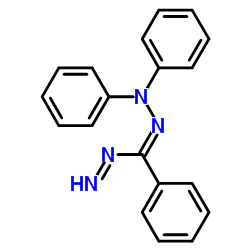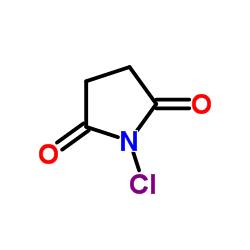2,3,5-Triphenyltetrazolium chloride

2,3,5-Triphenyltetrazolium chloride structure
|
Common Name | 2,3,5-Triphenyltetrazolium chloride | ||
|---|---|---|---|---|
| CAS Number | 298-96-4 | Molecular Weight | 334.802 | |
| Density | N/A | Boiling Point | >360 | |
| Molecular Formula | C19H15ClN4 | Melting Point | 250 °C(lit.) | |
| MSDS | Chinese USA | Flash Point | 91.7ºC | |
| Symbol |

GHS07 |
Signal Word | Warning | |
Use of 2,3,5-Triphenyltetrazolium chlorideTetrazolium Red(2,3,5-Triphenyltetrazolium chloride; TPTZ) is used to visualize dehydrogenase enzyme activity; initially the tetrazolium solution is colorless but changes to red when it comes into contact with hydrogen. Tetrazolium red is used in a biochemical viability test for seeds. The test relies on dehydrogenase enzymes to release hydrogen ions which subsequently reduce the colorless tetrazolium salt solution to a red compound called formazan. Living cells turn red while dead cells remain colorless. |
| Name | 2,3,5-triphenyltetrazolium chloride |
|---|---|
| Synonym | More Synonyms |
| Description | Tetrazolium Red(2,3,5-Triphenyltetrazolium chloride; TPTZ) is used to visualize dehydrogenase enzyme activity; initially the tetrazolium solution is colorless but changes to red when it comes into contact with hydrogen. Tetrazolium red is used in a biochemical viability test for seeds. The test relies on dehydrogenase enzymes to release hydrogen ions which subsequently reduce the colorless tetrazolium salt solution to a red compound called formazan. Living cells turn red while dead cells remain colorless. |
|---|---|
| Related Catalog |
| Boiling Point | >360 |
|---|---|
| Melting Point | 250 °C(lit.) |
| Molecular Formula | C19H15ClN4 |
| Molecular Weight | 334.802 |
| Flash Point | 91.7ºC |
| Exact Mass | 334.098511 |
| PSA | 34.59000 |
| LogP | 0.21500 |
| Vapour Pressure | 0.0615mmHg at 25°C |
| Storage condition | 2-8°C |
| Stability | Stable. Light sensitive. Protect from moisture. Incompatible with strong oxidizing agents. |
| Water Solubility | H2O: may be clear to slightly hazy |
CHEMICAL IDENTIFICATION
HEALTH HAZARD DATAACUTE TOXICITY DATA
|
| Symbol |

GHS07 |
|---|---|
| Signal Word | Warning |
| Hazard Statements | H315-H319-H335 |
| Precautionary Statements | P261-P305 + P351 + P338 |
| Personal Protective Equipment | Eyeshields;Gloves |
| Hazard Codes | Xi:Irritant |
| Risk Phrases | R36/37/38 |
| Safety Phrases | S26-S36 |
| RIDADR | NONH for all modes of transport |
| WGK Germany | 3 |
| RTECS | XF8100000 |
| HS Code | 2933990090 |
|
~95% 
2,3,5-Triphenyl... CAS#:298-96-4 |
| Literature: Balakrishnan, R.; Srinivasan, Vangular S. Indian Journal of Chemistry, Section B: Organic Chemistry Including Medicinal Chemistry, 1983 , vol. 22, # 8 p. 771 - 775 |
|
~86% 
2,3,5-Triphenyl... CAS#:298-96-4 |
| Literature: Katritzky, Alan R.; Belyakov, Sergey A.; Lam, Jamshed N.; Durst, H. Dupont; Karpenko, Dmitrii V. Heterocycles, 1994 , vol. 39, # 1 p. 73 - 80 |
|
~% 
2,3,5-Triphenyl... CAS#:298-96-4 |
| Literature: Journal of the American Chemical Society, , vol. 76, p. 1695 |
|
~% 
2,3,5-Triphenyl... CAS#:298-96-4 |
| Literature: Chemische Berichte, , vol. 86, p. 858,860 |
|
~% 
2,3,5-Triphenyl... CAS#:298-96-4 |
| Literature: Chemische Berichte, , vol. 86, p. 858,860 |
|
~% 
2,3,5-Triphenyl... CAS#:298-96-4 |
| Literature: Chemische Berichte, , vol. 27, p. 323,2928 |
| HS Code | 2933990090 |
|---|---|
| Summary | 2933990090. heterocyclic compounds with nitrogen hetero-atom(s) only. VAT:17.0%. Tax rebate rate:13.0%. . MFN tariff:6.5%. General tariff:20.0% |
|
Is sexual reproduction of high-mountain plants endangered by heat?
Oecologia 177(4) , 1195-210, (2015) Strong solar irradiation in combination with still air and dry soil can cause prostrate high-mountain plants to heat up considerably and ultimately suffer heat damage. Such heat damage has been repeat... |
|
|
Beneficial effect of butyrate, Lactobacillus casei and L-carnitine combination in preference to each in experimental colitis.
World J. Gastroenterol. 20(31) , 10876-85, (2014) To investigate the beneficial effect of the combination of butyrate, Lactobacillus casei, and L-carnitine in a rat colitis model.Rats were divided into seven groups. Four groups received oral butyrate... |
|
|
Biochemical and histopathological evidence on the beneficial effects of Tragopogon graminifolius in TNBS-induced colitis.
Pharm. Biol. 53(3) , 429-36, (2015) Tragopogon graminifolius DC. (Compositae) (TG) has been proposed as an efficacious remedy for gastrointestinal ulcers in Iranian traditional medicine.The present study evaluates the efficacy of TG on ... |
| 2,3,5-triphenyl tetrazolium chloride |
| TETRAZOLE RED |
| TTC |
| Red tetrazolium |
| triphenyltetrazolium chloride |
| urocheck |
| TPTZ,TTZ,Tetrazolium Red |
| TTL |
| EINECS 206-071-6 |
| vitastain |
| 2,3,5-Triphenyltetrazolium chloride |
| 2,3,5-Triphenyl-2H-tetrazol-3-ium chloride |
| tetrazolium red |
| 2H-Tetrazolium, 2,3,5-triphenyl-, chloride (1:1) |
| MFCD00011963 |
| 2,3,5-tetraphenyltetrazolium chloride |
| uroscreen |
| 2,3,5-triphenyl-2H-tetrazolium chloride |
| TTZ |







 CAS#:588-64-7
CAS#:588-64-7
